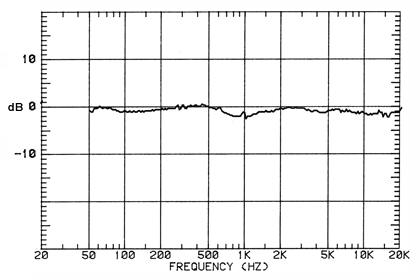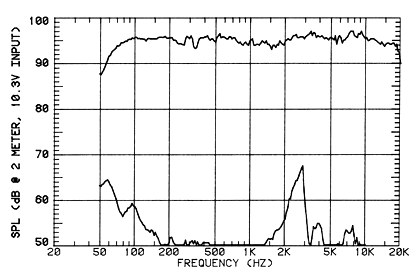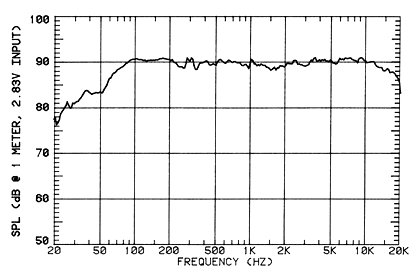I'm a little confused by all this Fletcher-Munson talk. I know what it means--no need to explain it to me. But what I don't get is this: The sensitivity of my hearing is the same in the seats of a concert hall as it is in my listening room. If the recording process is linear--from microphone to storage medium--and if the playback process is linear--from storage medium to loudspeakers--then the signal should sound the same to me as it would have were I sitting next to the microphone in the concert hall. I don't need to boost bass to make it sound the same, because I'm desensitized in the lower frequencies in the live venue as much as at home. Deliver to me the sound waves that arrived at the microphone and my hearing is what it is, at least when listening at reference volume.
Of course, that assumption of linearity is silly. The recording and playback chain is subject to a whole range of distortions, some of which are intentional. So, I do my best to add as little of that distortion for the parts I can control as possible.
My Revel F12's were tested in the Canadian National Research Council anechoic chamber and reported by Soundstage
here. They test for preservation of linearity by comparing the frequency response of the speaker at loud levels to the frequency response at 70dB, which they assume is the best baseline for the speaker's performance. The Revel F12 did better than other speakers they had tested (which is a long but by no means comprehensive list and now rather outdated just like the F12's), and got such good results at 95 dB SPL (average) that they tested it again at 100 dB SPL. They do not say if they use a weighted SPL curve, so I'm assuming it is unweighted. For some measurements, the SPL is determined by averaging the signal from 300 Hz to 3 KHz. They measure SPL at 2 meters, not the usual 1 meter, in the anechoic chamber. Thus, they get no room reinforcement, and doubling the distance reduces the SPL by 6 dB. So: 95 dB SPL is really 101 dB SPL measured at 1 meter the way most labs do it. But that two meters is fairly close to my listening distance, though in my living room I don't get the full 6 dB drop because of room reinforcement.
Deviation from linearity at 105 dB SPL (compared to 70 dB SPL):
Note that the additional 35 dB is causing additional distortion at around 1 KHz and in the top octave, causing the level to vary by up to 3 dB.
Assuming the speaker performs well at 70 dB, it isn't going to be all that much different in performance at 105 dB. 90 dB SPL, compared to 70 dB, was dead flat to the fraction of a dB.
They also tested distortion plus noise, and again the good performance at their usual level encouraged them to test again at a higher level. So, they tested at 95 dB SPL, again at 2 meters. Note that this is an average value, measured at 2 meters in an anechoic chamber. In my home, this would be like averaging 100 dB SPL, which is louder than an orchestra evens sitting in the middle of it (and, yes, I have measured that out of concern for my own hearing exposure). Peaks would be far higher at this average, probably 120 dB or more for dynamically recorded music. Remember my play-along-with-a-recording use case makes use of percussive peaks at 110 dB, which is, again, exactly what I measured from our energetic timpanist whacking away at the big kettle drum that is all of10 inches by poor Rick's head. It was abusive to my brain so I measured it--
peaks were at 108 dB SPLC--certainly less loud than the NRC's test protocol by something like 10 dB or more. Actually, more, because I'm playing two speakers not one.
Revel F12 speakers response and distortion when playing at an average of 95 dB SPL at two meters in an anechoic chamber:
Pushed this hard, distortion rose above 1% below about 120 Hz, and in the crossover region between the mid-range driver and the tweeter in the 2-3 KHz range.
To show how this compares to the usual tests, here is the frequency response in the anechoic chamber averaged across the +/- 15-degree (4 pi) listening window (go to the report if you want to see the full spin, where it performed very well):
Yes, output does drop below about 80 Hz, and that could be restored with a subwoofer. Subwoofers also can be placed to cancel the room modes to get a more linear response in the bass region. But even without a sub, the speakers play tuba sounds that are indistinguishable to my ears from hearing the instrument live. I'll have to conduct that test formally sometime--put a microphone in a room and record myself playing a note, interspersed randomly with the playback of a recording of myself playing the same note on the same tuba in the same room.
These are the sorts of tests that tell me whether a speaker can play loudly or not, it seems to me. I wish they were included in everyone's test protocols.
(The Revel Concerta F12 was the budget offering from Revel a dozen years ago or so, and it sports two 8" woofers, a 5-1/2" mid-range driver, and a 1" tweeter in Revels very special horn. Revel says they need amps from 20-200 WPC, and I'm running them--carefully--with nearly twice the upper number.)
Rick "my research process answering the same original question as the OP" Denney



